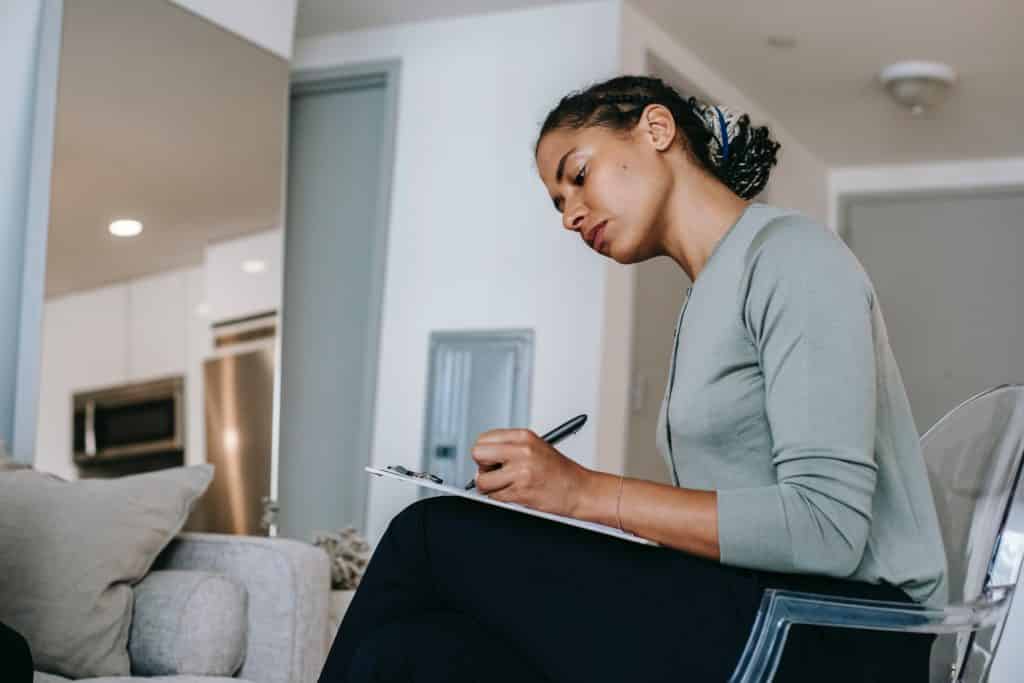This post may contain affiliate links, which means I’ll receive a commission if you purchase through my links, at no extra cost to you. Please read full disclosure for more information.
So, your dream company has invited you for an in-person interview. Congrats!
You’ve thoroughly researched the organization and potential interviewers. You’ve perfected answers to common questions and even picked a professional outfit that embraces your body and style.
But there’s still one area most young professionals fail: interview body language.
According to Dr. Albert Mehrabian (a renowned behavioral psychologist), words make up only 7% of overall communication, while the nonverbal component accounts for 93%.
Your non-verbal signals are just as critical as your words. And while a polished resume and compelling cover letter will land you an interview, your body language might be the ticket to the job.
Subtle cues like posture, facial expressions, and even handshakes communicate to potential employers whether you’re confident, qualified, and trustworthy or not. It’s why a weak handshake conveys nervousness or uncertainty, while eye contact makes you appear more involved and confident.
While nonverbal signals are often instinctive, recognizing and practicing them in a professional setting goes a long way to level up your appeal.
With that, I’d like to go over the importance of body language in interviews. You’ll also learn about the different messages nonverbal cues convey and how to use these signals to your advantage.
Let’s start with body language definition.
What is Body Language?
Body language is an element of communication where physical behavior, instead of words, conveys information. It includes facial expressions, body posture, gestures, eye movement, touch, and the use of space. The cues may seem subtle and inconsequential, but they do an excellent job revealing our true feelings and intentions.
We give off and interpret non-verbal signals almost entirely subconsciously. Regardless, you can always learn to use gestures and stances to impress interviewers. But more on that later.
Next, let’s summarize the importance of body language during an interview.
Why is Body Language Important During a Job Interview?
Interviewers will form their initial opinion of you in the first few seconds and then spend the rest of the interview trying to justify this opinion. They’ll analyze how you enter the room, shake their hands, sit, and speak. And surprisingly, that could happen subconsciously.
But you might be wondering: why is body language important in an interview?
Interview body language tells the kind of employee the company might hire. For example, walking standing straight with your shoulders pulled back and head held high reflects confidence and ability to handle pressure at work without cracking.
Non-verbal cues also show your ability to speak with confidence. It’s not just about being knowledgeable – it’s also about articulating messages correctly.
Take, for example, when a candidate stutters. That could indicate they don’t feel comfortable speaking in public or presenting themselves and could break their chances with a sales representative role.
Your body language in an interview demonstrates your professionalism. The company expects you to interact well with customers and colleagues. But if your non-verbal communication indicates a lack of professionalism, you could as well lose the opportunity.
For example, responding by shrugging your shoulders and nodding your head can be interpreted as arrogance. Wouldn’t you readily dismiss an arrogant candidate?
Messages You Can Send to the Interviewers
The messages you communicate with your body language can significantly impact how the recruiting team perceives you.
- Confidence
Did you know that 40% of hiring managers think that lack of confidence is enough reason to dismiss a candidate?
Supreme confidence is being relaxed and comfortable in your movements. It means making eye contact, keeping your head up and shoulders back, speaking clearly and directly, and assuming a good interview posture. That helps you appear more competent and trustworthy.
- Nervousness
Your body language can communicate nervousness just as easily as confidence. The telltales include hunched shoulders, crossed or closed-off arms and legs, fidgeting fingers or feet, avoiding eye contact, or other shifty movements.
A nervous person may also speak more quietly than usual and avoid making direct statements (e.g., “I think that…” instead of “I know that…”).
- You Are Lying
If ever there was a time to practice telling the truth, it’s during an interview. If your interview body language and words contradict, the recruiting team will likely believe your body language.
Signals that could indicate you’re lying include:
- Sudden eye deviations
- Stammering and throat clearing
- Sudden shifts in posture
- Fidgeting too much
- Dramatic changes in voice tone
- Enthusiasm
Your enthusiasm and excitement will come through in your facial expressions, gestures, and posture, especially when you’re answering questions. But don’t go overboard by gesticulating wildly because that could distract from what you’re saying.
- Responsiveness
Nodding, smiling, and leaning forward exhibits interest. And so is giving feedback on what interviewers say—something like “That’s interesting” or “I see what you mean” or “That sounds like a real challenge.”
- You’re a Team Player
Companies want individuals ready to work with their teams towards common objectives. It will be a turn-off if your interview body language suggests you’re too much of an individualist.
Make sure that your body language shows that you respect other people’s opinions besides yours.
7 Body Language Tips for a Job Interview
Here’re a few ways to use interview body language to communicate professionalism and confidence:
- Offer a confident handshake
- Assume a good interview posture
- Maintain proper eye contact
- Control your eye movements
- Be careful with your hands
- Mind your facial expressions
- Speak with a clear tone
- Greeting
You have 7 seconds to impress your interviewer, and greetings are an integral part of that.
A firm handshake coupled with a smile and a “Hello, Pleasure meeting you, Mr/Miss/Mrs [interviewer’s name]” communicates confidence and shows you’re ready for business.
Don’t crush the interviewer’s hand—of course, a handshake that’s too firm can hurt your chances just as much as a weak one.
Don’t offer a wet fish either! If your palms are sweaty, wipe them before going into the interview room.
When another representative enters the room during the interview, professional courtesy calls for you to stand and extend a handshake (unless requested otherwise).
- Posture
A positive interview posture projects openness, energy, and confidence. But take care not to come across as overbearing or overly familiar with the interviewer.
A stiff sitting position indicates nervousness, while sloppy sitting gives the impression of being careless or tired. Sit on the edge of your chair, and you’ll come off as tense and less confident.
Good interview posture includes:
- Walking into the interview room tall with your shoulders back (and down), your chin up, and firmly holding your belongings.
- Sitting up straight with your feet planted on the floor or crossed at the ankles.
- Leaning slightly forward (about 10 degrees)
- Eye Contact
Lack of eye contact gives the impression you’re nervous, hiding something, or uninterested. Such perceptions will work against you. Further, 65% of hiring managers admit to turning down candidates with poor eye contact.
Maintaining eye contact with the interviewer shows that you’re listening and engaged in the conversation. If it’s a panel interview, spread the gaze evenly around the room to form a rapport with the entire audience.
Don’t stare, though. A good rule of thumb is to look the interviewer in the eyes for one to two seconds at a time.
- Eye Movement
You may not realize this, but where your eye movements go can signal how interested or engaged you are. Looking down or off to the side while someone else is talking suggests boredom, shyness, or disinterest.
Darting your eyes when looking away indicates nervousness or shyness. As such, practice shifting your gaze unhurriedly.
- Hand Position
Another integral part of interview body language is what you do with your hands.
Sitting with the arms folded across your chest gives off a defensive and closed attitude. Twirling your hair is unprofessional and implies you’re nervous while waving hands around conveys uncertainty.
The best position is sitting with your hands on the table (or on your laps with the palms unfolded).
- Facial Expressions
Smile often—it makes you appear confident and likable. Plus, it helps put the interview panel at ease and build rapport.
At the same time, don’t force a smile or overdo it. You don’t want to come across as trying too hard or fake.
While it’s subconscious to purse the lips or frown when thinking, that may come off as being annoyed or disapproving. Your best bet is to pause and look away momentarily when pondering over a question.
- Voice Delivery
Intonation accounts for about 38% of your overall impression.
Speaking too softly makes you appear uncertain or shy while being too loud will come off as aggressive, annoying, or arrogant.
You want to speak with a normal voice and reasonably strong volume. Only then can the interviewer follow your train of thought without needing constant prompting. Pausing for a few seconds will prevent you from rushing through answers.
This may require some practice, but try keeping an upbeat tone when speaking about an exciting subject and a softer tone for more serious topics.
But again, don’t be too emotional or excited.
Summary
The impact of body language in an interview is more pronounced than your words. It can make or compromise your chances of success.
So what can you do?
Start paying attention to your nonverbal cues. Walk into the interview room smiling, offer a firm handshake, sit up straight, maintain eye contact, and overall project positive energy.
Please note that interview body language is best applied in moderation. While it’s critical to maintain eye contact and appear engaged, too much of it is intimidating. Similarly, don’t be afraid to lean towards the interviewer—but not too far forward.
By finding a reasonable balance between conversation and body language, you’ll give off the impression of a confident and capable candidate.



